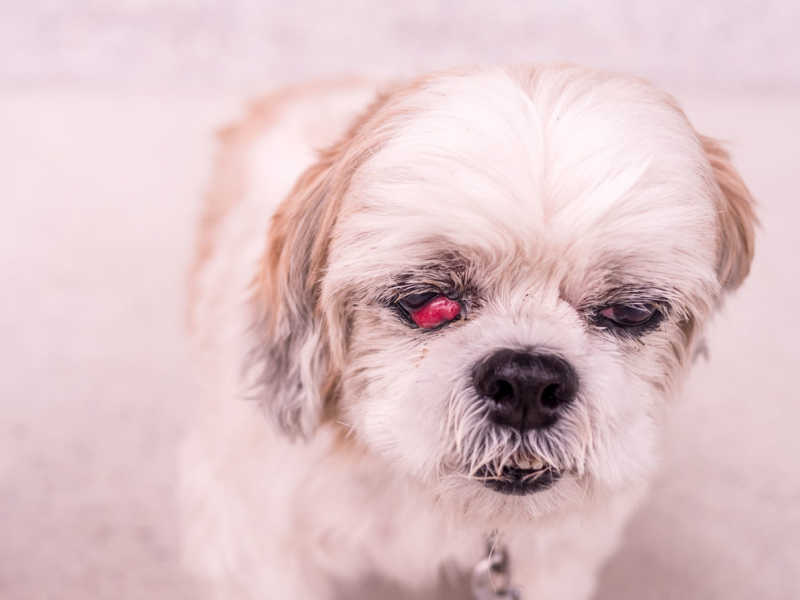Ah, the adorable Shih Tzu, with their big round eyes and fluffy coats. They’re truly a sight to behold! But what happens when those beautiful eyes start to look a little different? That’s where the phenomenon known as “cherry eye” comes into play. If you’re a Shih Tzu owner or thinking of becoming one, you might be wondering, “What causes cherry eye in Shih Tzu?” Well, fear not, because I’m here to shed some light on this peculiar condition.
Cherry eye, despite its cute-sounding name, is actually a rather unpleasant condition that can affect our beloved furry friends. It occurs when the gland that produces tears, known as the third eyelid gland, becomes inflamed and protrudes from the corner of the eye, resembling a small red cherry. Not the most appetizing image, I know! But what causes this peculiar phenomenon? Well, there’s no one-size-fits-all answer, as cherry eye can be caused by a variety of factors. It could be due to genetics, as certain breeds, like our dear Shih Tzus, are more prone to developing this condition. Other possible culprits include eye infections, allergies, or even trauma to the eye. So, if you notice your Shih Tzu sporting a cherry eye, it’s best to consult with a veterinarian to determine the underlying cause and get the proper treatment.
Now that we’ve uncovered the mystery behind cherry eye in Shih Tzus, you’ll be better equipped to understand this peculiar condition and take the necessary steps to keep your furry friend’s eyes in tip-top shape. Remember, knowledge is power, and being aware of what causes cherry eye can help you provide the best care for your adorable companion. So, stay vigilant, keep those eyes sparkling, and let’s keep our Shih Tzus looking as cute as ever!

What Causes Cherry Eye in Shih Tzu?
Cherry eye is a common condition that can affect Shih Tzus and other dog breeds. It is characterized by the prolapse or protrusion of the third eyelid, also known as the nictitating membrane. This condition is called cherry eye because the exposed gland often appears as a red, swollen mass that resembles a cherry. While the exact cause of cherry eye in Shih Tzus is not fully understood, there are several factors that may contribute to its development.
Genetics and Breed Predisposition
Genetics play a significant role in the development of cherry eye in Shih Tzus. It is believed that certain genetic factors can make some dogs more prone to this condition. Shih Tzus are among the breeds that are more susceptible to cherry eye. This means that if a Shih Tzu has cherry eye, there is a higher chance that their offspring may also develop the condition. It is important for breeders to be aware of this genetic predisposition and take steps to minimize the risk of passing it on to future generations.
Apart from genetics, there are other factors that can contribute to the development of cherry eye in Shih Tzus. These factors include:
Weak Connective Tissue
Shih Tzus, like other brachycephalic breeds, have a unique anatomy that can make them more prone to certain health issues. One such issue is weak connective tissue. The connective tissue that holds the gland in place may be weaker in some dogs, making it more likely to prolapse. This weakness can be the result of genetics or other factors, such as trauma or inflammation.
Environmental Factors
Environmental factors can also play a role in the development of cherry eye in Shih Tzus. Exposure to irritants, such as dust, allergens, or chemicals, can lead to inflammation of the eye. This inflammation can weaken the connective tissue and increase the risk of cherry eye. Additionally, dry environments or excessive exposure to wind can contribute to the development of this condition.
Treatment Options for Cherry Eye in Shih Tzus
If your Shih Tzu develops cherry eye, it is important to seek veterinary attention promptly. Early intervention can help prevent complications and minimize the risk of long-term damage to the eye. There are several treatment options available for cherry eye in Shih Tzus, including:
Medical Management
In some cases, cherry eye can be managed with medication. Your veterinarian may prescribe eye drops or ointments to reduce inflammation and promote the repositioning of the gland. However, it is important to note that medical management alone may not be sufficient to fully resolve the condition, and surgical intervention may be necessary.
Surgical Correction
Surgical correction is often recommended for cases of cherry eye that do not respond to medical management or when the condition is severe. The goal of surgery is to reposition the prolapsed gland and secure it in its normal position. There are different surgical techniques available, and your veterinarian will determine the most appropriate approach for your Shih Tzu.
Preventing Cherry Eye in Shih Tzus
While it may not be possible to completely prevent cherry eye in Shih Tzus, there are steps you can take to minimize the risk. If you are considering getting a Shih Tzu puppy, make sure to choose a reputable breeder who prioritizes the health and genetic screening of their breeding dogs. Regular eye examinations by a veterinarian can also help detect any early signs of cherry eye or other eye conditions, allowing for early intervention and treatment.
In conclusion, cherry eye is a common condition that can affect Shih Tzus. While the exact cause is not fully understood, genetics and weak connective tissue are believed to play a role. Environmental factors can also contribute to the development of this condition. Prompt veterinary attention and appropriate treatment are essential for managing cherry eye in Shih Tzus. By being proactive and taking steps to minimize the risk, you can help keep your Shih Tzu’s eyes healthy and prevent complications associated with cherry eye.
Key Takeaways: What Causes Cherry Eye in Shih Tzu?
- Cherry eye in Shih Tzu is caused by the prolapse of the third eyelid gland.
- Genetics play a role in the development of cherry eye in Shih Tzu.
- Environmental factors such as allergies or irritants can contribute to cherry eye.
- Injury or trauma to the eye area can also lead to cherry eye in Shih Tzu.
- Surgery is often required to correct cherry eye in Shih Tzu.
Frequently Asked Questions:
Question 1: Can genetics be a cause of cherry eye in Shih Tzu?
Yes, genetics can play a role in the development of cherry eye in Shih Tzu. The condition is believed to have a hereditary component, meaning it can be passed down from one generation to another. If a Shih Tzu has a close relative, such as a parent or sibling, that has experienced cherry eye, there is a higher likelihood of the condition occurring in that dog as well.
While genetics can be a contributing factor, it is important to note that other factors, such as environmental triggers or underlying health issues, can also influence the development of cherry eye in Shih Tzu.
Question 2: Are certain breeds more prone to cherry eye?
Yes, certain breeds, including Shih Tzu, are more prone to cherry eye. This condition is commonly seen in breeds with a predisposition for loose or weak connective tissue, which can affect the stability of the tear gland in the eye. Shih Tzu have a genetic predisposition to developing cherry eye, making them more susceptible to the condition.
It is important for Shih Tzu owners to be aware of this predisposition and monitor their dog’s eyes regularly for any signs of cherry eye.
Question 3: Can trauma cause cherry eye in Shih Tzu?
While trauma can potentially contribute to the development of cherry eye in Shih Tzu, it is not the sole cause. The condition is primarily caused by a weakening or malfunctioning of the connective tissue that supports the tear gland in the eye. Trauma, such as a blow to the face or excessive rubbing of the eyes, can exacerbate an existing condition or trigger the onset of cherry eye in dogs that are already genetically predisposed.
It is important to provide a safe and secure environment for your Shih Tzu to minimize the risk of trauma that could potentially lead to cherry eye.
Question 4: Can allergies contribute to cherry eye in Shih Tzu?
Allergies can potentially contribute to the development of cherry eye in Shih Tzu, although it is not a direct cause. Allergic reactions can cause inflammation and irritation in the eyes, leading to increased tearing and potential strain on the connective tissue supporting the tear gland. Over time, this can weaken the tissue and increase the risk of cherry eye.
If your Shih Tzu has allergies, it is important to manage them effectively through proper veterinary care and avoid potential allergens to minimize the risk of developing cherry eye.
Question 5: Can cherry eye be prevented in Shih Tzu?
While it may not be possible to completely prevent cherry eye in Shih Tzu, there are steps that can be taken to minimize the risk. Regular eye examinations by a veterinarian can help detect any early signs of the condition and prompt appropriate treatment. Additionally, avoiding trauma to the face and eyes, as well as managing any allergies or underlying health issues, can help reduce the likelihood of cherry eye occurring.
If your Shih Tzu does develop cherry eye, early intervention and treatment can help improve the outcome and reduce the risk of complications.
Cherry Eye in Dogs? | Dr. Lindsay Butzer explains it all! + How to fix it?
Final Thoughts on What Causes Cherry Eye in Shih Tzu?
After diving into the world of Shih Tzu and their adorable little eyes, it’s clear that cherry eye is a common concern for their owners. This condition, which occurs when the tear gland in the eye becomes inflamed and protrudes, can be quite distressing. However, understanding the causes of cherry eye is crucial in order to prevent it and provide the best care for our furry friends.
One of the primary causes of cherry eye in Shih Tzu is a genetic predisposition. It seems that these lovable pups are more prone to developing this condition due to their genetic makeup. Additionally, factors such as allergies, infections, and environmental irritants can also contribute to the onset of cherry eye. It’s important to remember that while we can’t control their genetics, we can take steps to minimize the risk by keeping their eyes clean and avoiding potential irritants.
In conclusion, cherry eye may be a common concern for Shih Tzu owners, but with proper care and awareness, we can minimize the chances of it occurring. By understanding the causes, such as genetics and environmental factors, we can take proactive measures to protect our furry companions. So, keep those adorable Shih Tzu eyes sparkling and healthy, and cherish every moment with your four-legged friend!


